 |
 Caves
Caves |

|
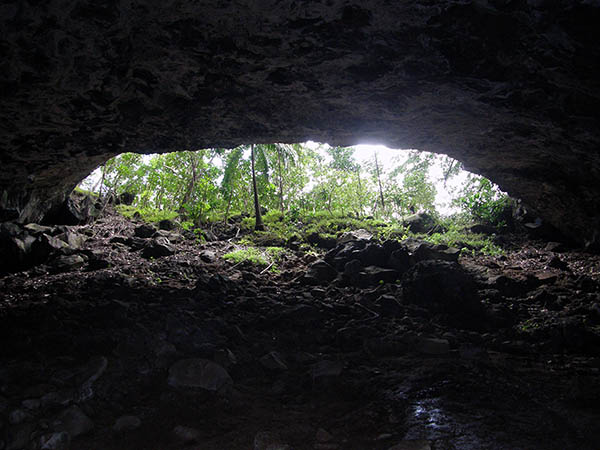
Looking out from Wai-a-Kanaloa cave.
“Come and Eat”
Caves are prominent features in the Hā‘ena landscape. Carlos relates the following story, set in one of the many caves along the Nā Pali coast, near Hā‘ena. In this story, Pele is passing through the area near one of these caves:
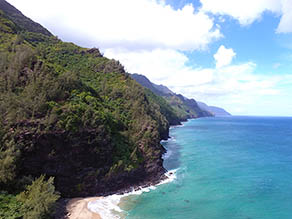
The Nā Pali Coast, stretching beyond Kē‘ē beach (foreground).
“This story takes place in a cave along the Nā Pali coast. There are caves still like this today—lots of them—cut out of the cliffs by the sea. In this story, there is a large cave and a lot of people living in it. At the time, these people had just brought in a large catch of fish, and are cooking them. Pele is wandering down the coast and seeing them, goes in to the cave and asks them for some fish to eat.
“But they deny her the fish. As she’s walking away from them, on the outskirts of the cave itself there's an old man and he's cooking fish for himself and his grandchild. And as Pele walks by, he calls her to come and eat with them. His invitation is the most pono Hawaiian behavior: whenever your see someone pass by, you call to them to come and eat, and even if they don’t respond or say ‘No, no thanks,’ it is your obligation as a host in Hawaiian culture to invite a stranger to come and eat with you.
“And so he calls her to eat, and they share the little fish that he has with her. Then before she leaves, Pele tells him not to stay in the cave that night—to go somewhere else. And later that night, all the people are all satisfied, fat and sleepy from their big meal, the cave collapses and kills them, all of them.”
Among the famous landmarks of Hā‘ena are three caves. There are various stories associated with these. Here are some recounted by Uncle Bruce:
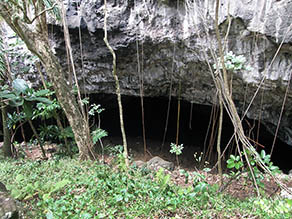
Entrance to Wai-a-Kanaloa.
Wai-a-Kanaloa
“Kanaloa was one of the four major Hawaiian gods, the brother of Kāne. The two were noted for digging sources of drinking water as they toured the various islands. The upper wet cave was dug by him and it is called Wai-a-Kanaloa, 'water made by Kanaloa.' Other legends say it was Pele who struck the cliff here with her staff Paoa when she was searching for a home, but was met by water instead.
“Hala-aniani, ‘clear pandanus,’ the lake of fresh water within the cave, was set aside for the ali'i; commoners could not bathe in it. The waters were thought to be able to restore an ailing person back to health. The chiefs either drank from a calabash filled with the water, or—better—swam in the underground lake.
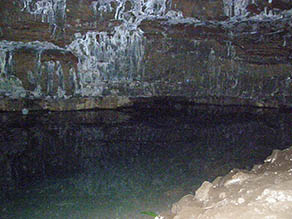
Hala-aniani.
“Pa-ka-moi, ‘enclosure of the threadfish,’ a boulder near the base of the upper wet cave, is also connected to the story of Pele and Lōhi‘au. When Hi‘iaka and her companion Wahine‘ōma‘o reached Hā‘ena, they asked Pakamoi, a fisherman, to find them a place to sleep for the night. He mistook the tenor of their request and after watching them loosen their clothes in preparation for sleeping, he attempted to fulfill his desires on Hi‘iaka. Hi‘iaka was saved by Pa‘u-o-Pala‘e, a friend and servant, who changed places with her. Pakamoi was turned into a stone where he lay.”
“My Grandma used to always say there was glass in there,” Lahela remembers, “and I was like, ‘What do you mean by glass? I don’t understand that.’ She goes, ‘It’s just like, if you was to walk on glass, would you walk on glass.’ I was like ‘No I wouldn’t.’ The concept was what she was trying to tell me. Instead of saying ‘No, you’re not supposed to go inside there,’ we was always taught that, and we never went inside."
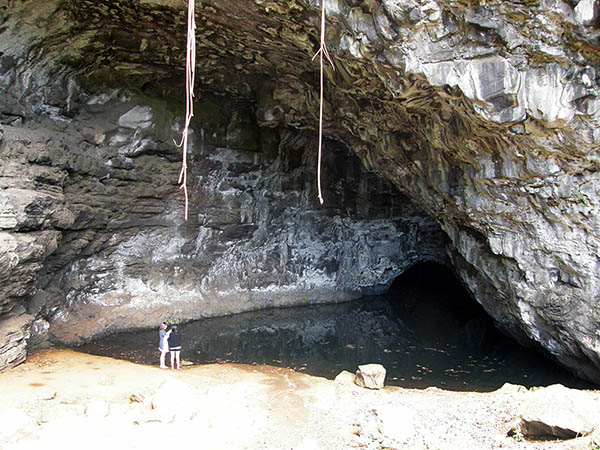
Wai-a-ka-Pala‘e Cave, near Hā‘ena Beach Park.
Wai-a-kapa-lae
Uncle Bruce continues: “The lower wet cave is Wai-a-ka-Pala‘e, ‘water of the lace fern.’ In olden times, the water in this cave had a brownish cast, which was said to be the hair of a beautiful mo‘o maiden who could usually be seen sitting near the entrance of the cave combing her hair. A chief from Wainiha fell in love with her and the two disappeared for several months. Then the mermaid reappeared with a baby at her breast. When asked where the chief was, she drew a finger across her neck to indicate he was dead. In revenge, his friends tried to kill the mo‘o, but she dove into the water and escaped. Her long hair spread out in the water, giving the pool its colored cast. As she grew older the brown tint turned to gray. For this reason, the cave was known either as Wai-a-kapa-lae, ‘water of terror,’ or as Wai-a-kapa-la‘e, ‘water of shiny tapa.’”
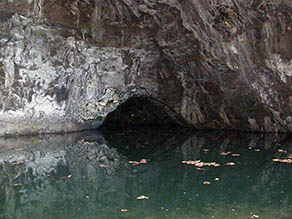
The inner cave.
“Kapalae, a kupua (a supernatural being possessing several body forms), lived in the cave Waikapalae (water of Kapalae),” Carlos says, “and often appearing in the form of a beautiful woman. She would come to the entrance of the cave every day to comb her long, lustrous, beautiful hair. Here she lured a handsome man beguiled by her very obvious charms to his doom.
"Today, newcomers have renamed this cave the Blue Room, another example of the renaming happening in Hā‘ena and in many other locales in Hawai‘i as a result of the increasing numbers of non-Hawaiians who now live there. However, the aura of the past still lingers in the memories of the elders, those descendants who still maintain the inherited familial relationship with the land and cherish connections to these ancient places.”
“When I was growing up I never went to what they call the blue room,” Lahela recounts. “It’s in Waikapalae, it’s above there where you go into the water. There’s a wall and you have to dive under, and you come into the room. If you know how dark it is, the water is pitch blue inside of there. And when I was young—how young I was, had to be 10th grad—I only went a couple times.
“And then I was involved in a festival in 1998. I speak to represent Kaua‘i, to be the ‘Queen of Kaua‘i.’ I did this for two years. And this kupuna was teaching us all the sites and the mo‘olelo of that place, for the mo‘o that lives in there. After that I was like, ‘What?!’ You know, I went swimming there—not all the time, I went a couple of times, not by myself, and I was like ‘OH!’ My parents never did this. I was supposed to have been taught already, but I was mischievous to go with my friends, my cousins here.
“The blue room in Waikapalae, you go in, it’s on your right maybe about half way in, you have to go in. You can kind of see it when the tide is in. It’s amazing. You’ve got to swim in. And sometime when the tide is down you can totally see where to go in. You didn’t have to dive under. Oh, dive under! What if I hit my head and not come up?
“There’s a mo‘o back there. That’s one of her places. That one is a female mo‘o. She was like with the guard that’s her home area. And the males are the prey that she’d feed on. There are a couple of people that had died inside there, and never came out. But it was all males. And so you never swim inside there, because that is her home and it’s like her safe haven.”
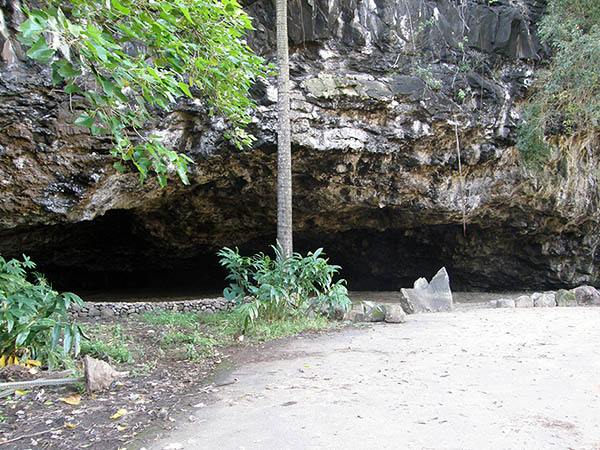
Maniniholo Cave, on the road across from Hā‘ena Beach Park.
Maniniholo Cave
“Kaiwiku‘i Ridge contains a large cave, Manini-holo, ‘traveling reef surgeonfish,’” Uncle Bruce finishes up. “Maniniholo was the head fisherman at the time the Menehune were leaving the island to return home. He brought his workers to gather food from the reefs and bay at Hā‘ena, but there was so much that they left some behind. During the night, all this food disappeared. Maniniholo saw little ‘e‘epa (imps) in fissures in the pali and realized that they were the thieves. He and his workers dug into the stone and killed the ‘e‘epa. The cave was named after the head fisherman. The Menehune gathered in the mountains and crossed Napali, eventually coming to the plain in front of Maniniholo. There they boarded their canoes that were waiting for them in Makua Bay. They sailed away and never returned.”
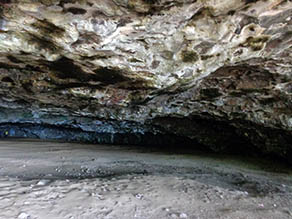
Inside Maniniholo Cave. Photo by Dawn Niederhauser.
Another story about Manini-holo cave is told by Mary Kawena Pukui:
Piliwale ka i‘a o Piliwale.
The fish of Piliwale press together.
Said of one who attaches himself to another.
Piliwale was a fishpond at Moloka‘i. When fresh sea water came in at the sluice gate the fish pressed together there. Once, a chief on Kaua‘i fled from the battlefield, followed by his pursuers. He found refuge in Maniniholo cave, but his pursuers discovered his place of concealment and entered. He fled, and, seeing a large rock, pressed himself against it with the hope that he would escape detection. But he was seen and killed. The rock against which he pressed himself was called Piliwale.
‘Olelo No‘eau #2656.
During the 19th and early 20th centuries, various notable visits to the caves by non-Hawaiian travelers took place. Read about them here.
|
 |






















